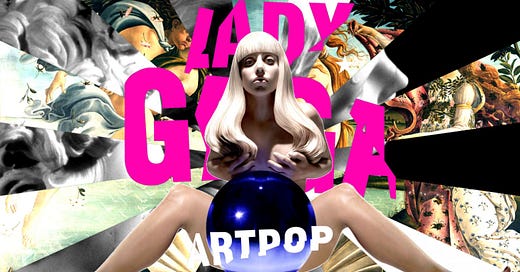ARTPOP: Did people get Lady Gaga's album wrong the first time?
Fresh speculation of the album's unreleased sequel has driven it back into the charts
Towards the end of her idea-filled 2013 album, Lady Gaga pulls off something she does well. A singer prone to shape-shifting costumes and personas, she transforms into something new.
“One second I'm a Koons, then suddenly the Koons is me,” she sings on “Applause,” an electro-pop paean to the sought glory of entertainers. Gaga is a passionate fan of Jeff Koons’s visual art, and, in ARTPOP’s roam through Greek and Roman mythology, she undergoes the Ovidian metamorphosis of a Koons statue brought to life. The album cover evokes Koon’s sculpture of Gaga cupping her breasts over a mysterious blue orb. He contributed blankly modern creations to the album’s promotional concert in a Brooklyn shipyard where screens projected Koon’s name in equal billing with Gaga, on the opposite side of the East River to the music arenas of midtown Manhattan.
As fresh speculation of the album’s unreleased sequel recently drove it back into the charts, much re-evaluation of ARTPOP has chosen to ignore its crossover between visual art and pop music. Clearly, that was never its main draw. Andy Warhol - Gaga’s hero - disrupted the rules of fine art but he hardly made that world less elitist. Echoing the multidisciplinary collaboration between Warhol and The Velvet Underground resulting in their blurry debut album, Gaga recruited Koons to invert Warhol’s achievement, giving pop music the prominence reserved for visual art. Wasn’t pop music already serious?
ARTPOP’s main innovation has always been its sound. To this era of familiar comforts, where disco synths flow through much of pop music, Gaga’s sonics sound more elaborate. Aided by songwriting partner D.J. White Shadow, she fortifies the album with dramatic synth-pop songs propelled by booming rock guitars and drums. The four-on-the-floor rhythm doesn’t let up until the piano lament “Dope” in the album’s end stretch. Strange, built-up verses lift for earnest choruses. On “Venus,” for instance, there are sci-fi flashes of a space launch, cheeky risqué portraiture of a Roman Goddess, before we reach a more revealing metaphor: “When you touch me, I die / Just a little inside / I wonder if this could be love”?
Gaga teases showing her true self on ARTPOP, to let us know “the girl who lives behind the aura” she says on eccentric opener “Aura,” but she doesn’t deliver. She later took superficial approaches to sincerity, with the stripped-back instrumentations of a jazz album and a country album. Recently, on Chromatica, Gaga showed she can be vulnerable on a dance-pop album but its sound is decidedly retro, its fingerprints recognisable. Precedents for ARTPOP are much more difficult to pinpoint. That might have something to do with its production team. “Venus” gets its chorus and bridge from protégé-songwriter Madeon, who was 19 at the time of production, and who also helped drive “Mary Jane-Holland,” a loud, dark grandiose song about Gaga’s addiction to marijuana. (Madeon also co-wrote the story of her reliance on anti-psychotic medication on Chromatica’s “911”).
Wading through the lusty synth of “Sexx Dreams” and the techno manifesto “ARTPOP,” who cares about a more exposed, personal Gaga when ARTPOP is this enjoyably weird. The greatest achievement is “G.U.Y,” where, with co-writer Anton Zaslavski, she crafts a rarefied hybrid of house music, industrial and R&B. Gaga directed a mythology-themed music video filmed in Hearst Castle, with the affluent cast of The Real Housewives of Beverley Hills playing court musicians. Populating the classical world of Renaissance paintings with the renegade, wealthy celebrities of reality television, Gaga’s video for “G.U.Y.” is her true match for Warhol’s pop art.
ARTPOP wasn’t a definitive commercial or critical success when it was released, tempting the question of if people judged the album wrongly? Tangled as it was in a multidisciplinary concept placing pop music in the awkward position of cowing to the dominance of visual art, it’s possibly more accurate that ARTPOP got ARTPOP wrong, misunderstanding the source of its power, making the do-over of a sequel all the more tantalising.
The broken boundaries on here are sonic, and those trespasses still fascinate. Zaslavski and Gaga also co-wrote “Donatella,” a tongue-in-cheek grotesquerie of Donatella Versace as a fashion world villain. It’s camp, bitchy but when the buzzing electronic beats disperse, the song instantly sounds reverential. “What do you want to wear this spring? / What do you think is the new thing?” asks Gaga. It’s not an unserious question.




